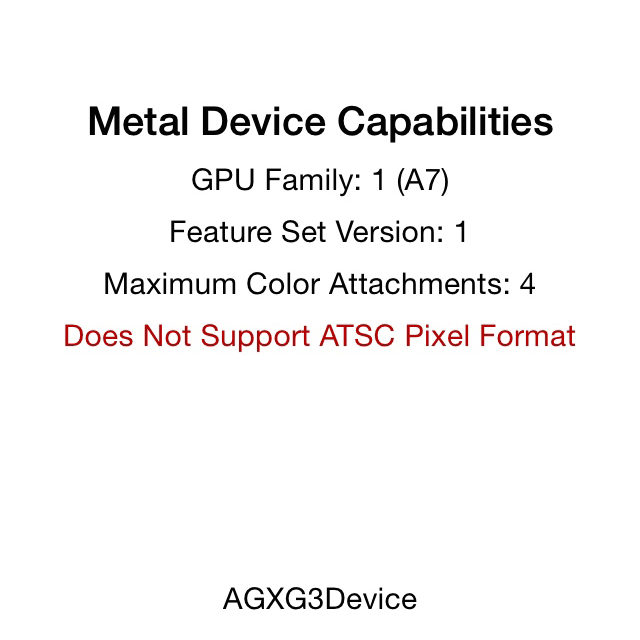One of the changes made to the Metal API in the iOS 8 GM was the addition of the supportsFeatureSet: method to the MTLDevice protocol. The purpose of this method is to differentiate between devices powered by the A7 and A8 processor, because these chips offer different capabilities to Metal.
Feature Sets
Feature sets are characterized by two values: a GPU generation, and a feature set version. Apple’s documentation on feature sets currently documents two feature sets: GPU generation 1, version 1; and GPU generation 2, version 1. These are declared as follows:
typedef enum : NSUInteger {
MTLFeatureSet_iOS_GPUFamily1_v1 = 0,
MTLFeatureSet_iOS_GPUFamily2_v1 = 1
} MTLFeatureSet;
You can query whether a particular feature set is available on the current device by calling supportsFeatureSet: on a Metal device. GPUFamily1 is explicitly identified by Apple with the A7 processor, while GPUFamily2 corresponds to the A8, the processor in the iPhone 6 and iPhone 6 Plus.
There are not too many substantial differences between the two, except that the A8 supports a greater number of color attachments on render passes (eight, instead of the four supported by the A7). The A8 also adds support for Adaptive Scalable Texture Compression (ATSC), a relatively new compression available in Metal on the newest iOS devices.
Capabilities
The sample project includes a class called MBEDeviceCapabilities with the following interface:
@interface MBEDeviceCapabilities : NSObject + (instancetype)capabilitiesWithDevice:(id<MTLDevice>)device; @property (readonly) NSUInteger highestSupportedFeatureSet; @property (readonly) NSUInteger featureSetGPUFamily; @property (readonly) NSUInteger featureSetVersion; @property (readonly) NSUInteger maximumRenderPassColorAttachments; @property (readonly) BOOL supportsASTCPixelFormats; @end
Creating an instance of MBEDeviceCapabilities produces an object that can supply the more granular device capability information displayed in the screenshots. This class infers the capabilities of the device based on the supported feature set reported by the device.
The sample app for this post displays the capabilities of the device the program is running on. For example, when running on an iPhone 6, the following display appears:

In contrast, here is the display for an iPhone 5s, which has the older A7 processor:

The bottom line on the display shows the concrete type of the Metal device returned by MTLCreateDefaultSystemDevice. When running under the debugger, this is always MTLDebugDevice. Interestingly, when not running under the debugger, the device class is device-specific: AGXG3Device (for iPhone 5s and iPad mini with Retina display) or AGXG4PDevice (for iPhone 6).
You can download the sample code for this post here. If you run the project on your own device and see a different device class, please let us know in the comments.